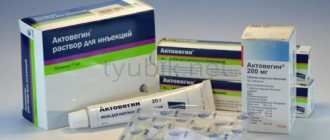Pharmacological properties of the drug Captopril
Pharmacodynamics . Captopril is the first synthetic ACE inhibitor. By blocking the conversion of angiotensin I to angiotensin II, it has a vasodilating effect, thereby reducing peripheral vascular resistance (afterload), wedge pressure in the pulmonary capillaries (preload) and pressure in the pulmonary vessels; increases IOC and exercise tolerance. With long-term use, captopril reduces the severity of left ventricular myocardial hypertrophy. Reduces the tone of the efferent arterioles of the glomeruli of the kidneys, thereby improving intraglomerular hemodynamics and preventing the development of diabetic nephropathy. Pharmacokinetics . When taken orally, the drug is quickly and almost completely (at least 75%) absorbed into the gastrointestinal tract. In the presence of food, bioavailability is reduced by 30–40%. The maximum concentration in blood plasma is reached after 30–90 minutes. Protein binding, predominantly albumin, is 25–30%. Penetrates through histohematic barriers, including the blood-brain barrier, and crosses the placenta. Metabolized in the liver. The half-life is less than 3 hours and increases with renal failure. It is excreted mainly by the kidneys in the form of metabolites and unchanged (up to 50%). Within 24 hours, up to 25% of the drug is eliminated. The maximum decrease in blood pressure after taking the drug orally is observed after 60–90 minutes. The duration of the hypotensive effect is dose-dependent and reaches optimal values within several weeks.
Use of the drug Captopril
The drug is used in adults; orally 1 hour before meals. AH (arterial hypertension) . The initial dose of Captopril-KMP for adults is usually 12.5 mg 2 times a day (captopril preparations with the possibility of such a dosage should be used). You should pay attention to the tolerability of the 1st dose during the first hour. If arterial hypotension develops, the patient is transferred to a horizontal position (this reaction to the first dose should not cause drug withdrawal). The usual maintenance dose for mild to moderate hypertension (arterial hypertension) (diastolic pressure - 95–114 mm Hg) is 25 mg (sometimes 12.5 mg 2 times a day). During a course of treatment, the dose of the drug is increased, if necessary, after 2–4 weeks, to a maximum of 50 mg 3 times a day. The maximum daily dose is 150 mg. For severe hypertension (arterial hypertension) (diastolic pressure 115 mm Hg and above), it is often combined with other antihypertensive drugs, often with thiazide diuretics (hydrochlorothiazide - 25-50 mg / day). The dose of the diuretic can be increased at intervals of 1–2 weeks until the maximum dose used in the treatment of hypertension (arterial hypertension) is reached. For elderly patients, the initial dose is 6.25 mg 2 times a day (captopril preparations with the possibility of this dosage should be used). Heart failure . The initial dose is 6.25 mg 3 times a day with a gradual (as needed) dose increase to 25 mg 2-3 times a day. In case of chronic heart failure, it is used simultaneously with diuretics and/or in combination with digitalis preparations (to prevent an initial excessive decrease in blood pressure, the diuretic should be discontinued or the dose reduced before captopril is prescribed). The maximum daily dose is 150 mg. Myocardial infarction . The initial dose is 6.25 mg/day, then the daily dose is increased to 37.5–75 mg in 2–3 doses (depending on the tolerability of the drug) up to a maximum of 150 mg/day. If arterial hypotension develops, it may be necessary to reduce the dose of the drug. Diabetic nephropathy . Captopril is used at a dose of 75–100 mg/day in 2–3 doses. With a total protein clearance of 500 mg/day, the drug should be taken at a dose of 25 mg 3 times a day. For insulin-dependent diabetes mellitus with microalbuminuria (albumin excretion 39–300 mg/day), take 50 mg 2 times a day. If necessary, combine with other antihypertensive drugs: diuretics, β-adrenergic receptor blockers, centrally acting drugs or vasodilators. Renal dysfunction . For mild renal impairment (creatinine clearance of at least 30 ml/min/1.73 m2) in patients with diabetic nephropathy, a daily dose of 75–100 mg is used in several doses. In case of severe renal impairment (creatinine clearance ≤30 ml/min/1.73 m2), the initial dose should not exceed 6.25 mg 2 times a day. Next, the dose is selected depending on the clinical effect, but not more often than once every 1–2 weeks, and not exceeding the maximum daily dose of 75 mg.
Contraindications to the use of the drug Captopril
Hypersensitivity to the drug or other ACE inhibitors; Quincke's edema (including a history of use of ACE inhibitors, hereditary); pregnancy (can cause severe dysplasia and fetal death) and breastfeeding (stop for the period of treatment); stenosis of the aortic mouth or the presence of other obstructions to the outflow of blood from the left ventricle; bilateral renal artery stenosis or unilateral stenosis of a solitary kidney with progressive azotemia; hyperkalemia; condition after kidney transplantation; primary hyperaldosteronism.
Contraindications
How to take Captopril for high blood pressure so that the treatment is effective and safe? First of all, it is necessary to take into account the list of contraindications.
These include:
- pregnancy, lactation and breastfeeding;
- renal artery stenosis diagnosed on both sides;
- stenosis of the renal artery, if this organ functions alone;
- an increase in blood levels of nitrogenous products excreted by the kidneys;
- liver diseases;
- low blood pressure;
- individual intolerance and allergic reactions to drugs from the group of ACE inhibitors.
Particular attention to well-being after taking Captopril should be paid to patients with infectious diseases, for example, systemic lupus erythematosus
During the first 21 days after treatment of the disease, the number of leukocytes in the blood serum of such patients is increased, so when taking the drug they need to monitor their blood count twice a month, and after that - once every 60 days. If there are signs of infectious diseases while taking Captopril, the patient should consult a doctor.
You cannot stop taking the medication yourself, without stopping it from your doctor, as well as change the dose and frequency of use recommended by the doctor.
What should I do if I experience vomiting, diarrhea, and increased sweating while taking the medication? Urgently call an ambulance or visit a doctor, as excessive sweating provokes a state of severe hypotension. With a sharp decrease in blood pressure in hypertensive patients, the risk of myocardial infarction increases significantly.
Side effects of the drug Captopril
from the central nervous system: dizziness, headache, feeling of fatigue, asthenia; from the cardiovascular system: orthostatic hypotension, rarely - tachycardia; from the gastrointestinal tract: nausea, loss of appetite, rarely - abdominal pain, diarrhea, increased activity of liver transaminases; from the urinary system: deterioration of kidney function; from the blood system: rarely - neutropenia, very rarely in patients with autoimmune diseases - agranulocytosis; from the respiratory system: dry cough; from laboratory parameters: hyperkalemia, proteinuria; allergic reactions: skin rash, rarely - angioedema, bronchospasm.
Advantages of the drug
Why is the drug Captopril considered very effective for the treatment of hypertension and heart failure? This is explained by a number of undeniable advantages over similar drugs:
- according to studies, the mortality rate from diseases of the cardiovascular system with regular use of Captopril is significantly reduced;
- the drug lowers blood pressure as effectively as other drugs from the main classes intended to relieve symptoms of hypertension;
- does not pose a danger to elderly patients;
- slows down the development of symptoms of kidney diseases, even those arising against the background of diabetes mellitus;
- does not reduce erectile function in men;
- acts on the body as a whole, providing an antioxidant effect on tissues and blood vessels;
- reduces the risk of malignant tumors many times more effectively than other classes of medications.
In addition to the listed advantages of using Captopril in the treatment of hypertension, the drug is affordable, in contrast to analogues and products with a similar chemical composition. Therefore, patients and doctors have long considered Captopril to be the gold standard in the treatment of hypertension, high blood pressure and pathologies of the cardiovascular system.
Special instructions for the use of the drug Captopril
Hypovolemia and electrolyte imbalance must be compensated before starting treatment with Captopril-CMP, since there is a risk of developing severe arterial hypotension. The possibility of a sharp decrease in blood pressure can be minimized by preliminary withdrawal (4-7 days before) of the diuretic or an increase in NaCl intake (approximately 1 week before starting the drug) or by using captopril at the beginning of treatment at a lower dose (6.25-12 .5 mg/day). Before starting treatment, as well as regularly during therapy with Captopril, renal function should be monitored. Particular caution is required when prescribing Captopril-CMP to patients with autoimmune diseases due to the increased risk of neutropenia and agranulocytosis. It is necessary to monitor the number of leukocytes in the blood in the first 3 months of treatment every 2 weeks, then every 2 months. If the leukocyte count is ≤4000/μl, a complete blood count is performed; if the count is ≤1000/μl, the drug is discontinued. During treatment with Captopril, a low sodium diet is used. When using Captopril, there may be a false positive reaction when testing urine for acetone. The effectiveness and safety of Captopril in children have not been established. Caution should be exercised when driving vehicles and operating other machinery , as dizziness may occur, especially after taking the initial dose of Captopril.
Captopril
Arterial hypotension
In patients with arterial hypertension, when using captopril, severe arterial hypotension is observed only in rare cases. The likelihood of developing this condition increases with increased fluid loss and hyponatremia (for example, after intensive treatment with diuretics, restriction of sodium intake, in patients on dialysis, and in patients with diarrhea or vomiting).
Captopril should be prescribed with caution to patients on a low-salt or salt-free diet. Circulating blood volume and blood sodium levels should be adjusted before captopril is prescribed. The possibility of a sharp decrease in blood pressure can be minimized by first withdrawing (4-7 days before) the diuretic or increasing sodium chloride intake (about a week before starting treatment), or by prescribing low doses of captopril at the beginning of treatment (6.25-12 .5 mg/day). Renal function should be regularly monitored before and during treatment with captopril. Excessive reduction in blood pressure due to antihypertensive medications may increase the risk of myocardial infarction or stroke in patients with coronary heart disease or cerebrovascular disease. If arterial hypotension develops, the patient should take a horizontal position with legs elevated.
Intravenous administration of 0.9% sodium chloride solution may be required.
In patients with CHF, a transient decrease in blood pressure by more than 20% of the initial value is observed in approximately half of the cases. The degree of reduction in blood pressure is maximum in the early stages of treatment (after taking the first few doses of captopril) and stabilizes within one to two weeks from the start of treatment. Blood pressure usually returns to baseline without a decrease in therapeutic efficacy within two months. In patients with CHF, treatment should begin with low doses of captopril (6.25-12.5 mg/day) under medical supervision. Increasing the dose of captopril should be done with extreme caution. Transient arterial hypotension in itself is not a reason to discontinue treatment. In cases where arterial hypotension becomes stable, the dose should be reduced and/or discontinued use of the diuretic and/or captopril.
Aortic or mitral stenosis/hypertrophic obstructive cardiomyopathy
Like all drugs that have a vasodilating effect, ACE inhibitors should be used with extreme caution in patients with left ventricular outflow tract obstruction. In case of hemodynamically significant obstruction, the use of captopril is not recommended.
Renal dysfunction
Some patients with kidney disease, especially those with severe renal artery stenosis, experience increases in serum urea nitrogen and creatinine concentrations after lowering blood pressure. This increase is usually reversible when captopril therapy is discontinued. In these cases, it may be necessary to reduce the dose of captopril and/or discontinue the diuretic.
With long-term use of captopril, approximately 20% of patients experience an increase in serum urea and creatinine concentrations by more than 20% compared to normal or baseline values.
In less than 5% of patients, especially with severe nephropathy, treatment discontinuation is required due to an increase in creatinine concentration.
Renovascular hypertension
Patients with bilateral renal artery stenosis or stenosis of the artery of a solitary kidney have an increased risk of developing arterial hypotension and renal failure when using ACE inhibitors. Renal failure may initially manifest itself as only slight changes in plasma creatinine levels. The use of captopril in such patients is not recommended.
Kidney transplant
There is no experience with the use of captopril in patients who have recently undergone kidney transplantation. Therefore, the use of captopril in such patients is not recommended.
Proteinuria
When using captopril, 0.7% of patients experienced proteinuria greater than 1000 mg per day. In 90% of cases, proteinuria occurred in patients with impaired renal function, as well as when using high doses of captopril (more than 150 mg per day). Approximately 20% of patients with proteinuria developed nephrotic syndrome. In most cases, proteinuria disappeared or decreased in severity after taking captopril within 6 months, regardless of whether the drug was stopped or not. Renal function indicators (blood urea nitrogen and creatinine concentrations) in
patients with proteinuria were almost always within normal limits. In patients with kidney disease, the protein content in the urine should be determined before starting treatment and periodically throughout the course of therapy.
Liver dysfunction
In rare cases, the use of ACE inhibitors has been accompanied by the development of a syndrome that begins with the appearance of cholestatic jaundice or hepatitis and progresses to fulminant liver necrosis, sometimes with death. The mechanism of development of this syndrome is unknown. If a patient receiving ACE inhibitor therapy develops jaundice or a significant increase in liver enzyme activity, captopril treatment should be discontinued and appropriate adjuvant therapy should be instituted. The patient should be under appropriate supervision.
Neutropeia/agranulocytosis/thrombocytopeia/anemia
In patients taking ACE inhibitors. cases of neutropenia/agranulocytosis, thrombocytopenia and anemia were noted. Neutropenia is rare in patients with normal renal function and no other abnormalities. In renal failure, simultaneous administration of captopril and allopurinol led to neutropenia.
Captopril should be used with extreme caution in patients with systemic connective tissue diseases (systemic lupus erythematosus, scleroderma, etc.) taking immunosuppressants, allopurinol or procainamide, or a combination of these complicating factors, especially if there are pre-existing renal dysfunction.
In 13% of cases, neutropenia resulted in death. In almost all cases, death was observed in patients with connective tissue diseases, renal or heart failure, while taking immunosuppressants, or a combination of both of these factors.
Due to the fact that the majority of fatal cases of neutropenia due to ACE inhibitors developed in such patients, their white blood cell count should be monitored before starting treatment, in the first 3 months - every 2 weeks, then every 2 months. In all patients, the number of leukocytes in the blood should be monitored monthly in the first 3 months after starting captopril therapy, then every 2 months. If the number of leukocytes is below 4000/μl, a repeat general blood test is indicated; below 1000/μl, the drug is stopped while monitoring the patient continues. Typically, restoration of the number of neutrophils occurs within 2 weeks after discontinuation of captopril.
Some patients developed serious infectious diseases, which in some cases did not respond to intensive antibiotic therapy. When using captopril in patients with a high risk of neutropenia/agranulocytosis, regular monitoring of the number of leukocytes in the blood is recommended. Patients should be warned to seek immediate medical attention if any signs of an infectious disease (eg, fever, sore throat) occur.
Hypersensitivity reactions/agioedema
Rare cases of angioedema of the face, extremities, lips, tongue, vocal folds and/or larynx have been observed with the use of ACE inhibitors, including captopril. Angioedema may develop at any time during treatment. If angioedema develops, you should immediately stop taking captopril and carefully monitor the patient's condition until symptoms disappear completely.
If the swelling is localized to the face, no special treatment is usually required (antihistamines can be used to reduce the severity of symptoms). Even in cases where only swelling of the tongue is observed without the development of respiratory distress syndrome, patients may require long-term observation, since therapy with antihistamines and corticosteroids may not be sufficient.
Angioedema, associated with swelling of the larynx and tongue, can be fatal in very rare cases. If the swelling spreads to the tongue, pharynx or larynx and there is a threat of developing airway obstruction, 0.3-0.5 ml of a 0.1% solution of epinephrine (adrenaline) should be immediately administered subcutaneously and/or the airway should be ensured ( intubation or tracheostomy). In rare cases, during therapy with ACE inhibitors, intestinal edema (angioedema of the intestines) has developed, which is manifested by abdominal pain in combination with or without nausea and vomiting, sometimes without previous angioedema of the face and with normal levels of Cl-esterase. Diagnosis is made using abdominal computed tomography, ultrasound, or surgery. Symptoms disappeared after stopping the ACE inhibitors. The possibility of developing intestinal edema must be taken into account when carrying out the differential diagnosis of abdominal pain in patients taking ACE inhibitors.
Patients with a history of angioedema not associated with ACE inhibitors may be at greater risk of developing angioedema during ACE inhibitor therapy.
In representatives of the Negroid race, cases of the development of angioedema when using ACE inhibitors were observed with a higher frequency compared to representatives of other races.
An increased risk of angioedema was observed in patients concomitantly taking ACE inhibitors and drugs such as mTOR inhibitors (temsirolimus, sirolimus, everolimus), dipeptidyl peptidase type IV inhibitors (sitagliptin, saxagliptin, vildagliptin, linagliptin), estramustine, neutral endopeptidase inhibitors (racecadotril). , sacubitril) and tissue plasminogen activators.
Anaphylactoid reactions during desensitization with an allergen from Hymenoptera venom
In rare cases, during therapy with ACE inhibitors, life-threatening anaphylactoid reactions were observed in patients undergoing desensitization with an allergen from the venom of Hymenoptera. In such patients, these reactions were prevented by temporarily stopping ACE inhibitor therapy before desensitization began. The use of captopril should be avoided in patients receiving bee venom immunotherapy.
Anaphylactoid reactions during low-density lipoprotein apheresis (LDL apheresis)
Life-threatening anaphylactoid reactions have rarely been observed in patients taking ACE inhibitors during LDL apheresis using dextran sulfate. The development of these reactions can be prevented by temporarily stopping the inhibitor
ACE before each LDL apheresis procedure.
Hemodialysis using high-flow membranes
When performing hemodialysis in patients receiving ACE inhibitors, the use of high-flow polyacrylonitrile dialysis membranes (for example, AN69®) should be avoided, since in such cases the risk of developing anaphylactoid reactions increases. In such cases, it is necessary to use a different type of dialysis membrane or use antihypertensive drugs of other classes.
Diabetes
In patients with diabetes mellitus receiving oral hypoglycemic agents or insulin while using ACE inhibitors, blood glucose concentrations should be regularly monitored.
Patients taking oral hypoglycemic agents or insulin should be informed before starting the use of ACE inhibitors of the need to regularly monitor blood glucose concentrations (hypoglycemia), especially during the first month of simultaneous use of these drugs.
Cough
When taking ACE inhibitors, a characteristic cough is often observed. As a rule, the cough is non-productive, constant and stops after discontinuation of the drug. Cough associated with the use of ACE inhibitors. should be taken into account in the differential diagnosis of dry cough.
Surgery/general anesthesia
During major surgical operations, as well as when using general anesthesia agents that have an antihypertensive effect, patients taking ACE inhibitors may experience an excessive decrease in blood pressure (since captopril blocks the formation of angiotensin II, caused by compensatory release of renin). In such cases, to correct low blood pressure, measures aimed at increasing the volume of circulating blood are used.
Hyperkalemia
In some cases, against the background of the use of ACE inhibitors, incl. captopril, an increase in serum potassium levels is observed.
Risk factors for the development of hyperkalemia are renal failure, old age (over 65 years), diabetes mellitus, some concomitant conditions (decrease in blood volume, acute heart failure in the stage of decompensation, metabolic acidosis), simultaneous use of potassium-sparing diuretics (such as spironolactone, eplerenone, triamterene or amiloride), as well as potassium preparations, potassium-containing table salt substitutes and other drugs that increase the level of potassium in the blood plasma (such as heparin, tacrolimus, cyclosporine; drugs containing cotrimoxazole [trimethoprim + sulfamethoxazole]).
The use of potassium supplements, potassium-sparing diuretics, or potassium-containing table salt substitutes, especially in patients with impaired renal function, can lead to a significant increase in serum potassium levels. Hyperkalemia can cause serious heart rhythm disturbances, sometimes fatal. It is recommended to avoid the simultaneous use of potassium-sparing diuretics and potassium supplements. If it is necessary to simultaneously use captopril and the drugs listed above containing potassium or increasing the potassium content in the blood plasma, caution should be exercised and the potassium content in the blood serum should be regularly monitored.
Hypokalemia
When using ACE inhibitors simultaneously with thiazide diuretics, the risk of hypokalemia cannot be excluded. Therefore, in such cases, regular monitoring of potassium levels in the blood should be carried out during therapy.
Dual blockade of the renin-angiotensin-aldosterone system (RAAS)
The simultaneous use of drugs from different groups that act on the RAAS is not recommended (double blockade of the RAAS), since it has been associated with an increased incidence of side effects such as arterial hypotension, hyperkalemia, and decreased renal function (including acute renal failure). The simultaneous use of ACE inhibitors with medicinal products containing aliskiren is contraindicated in patients with diabetes mellitus and/or with moderate or severe renal impairment (GFR less than 60 ml/min/1.73 m2 body surface area) and is not recommended in other patients.
Concomitant use of ACE inhibitors with angiotensin II receptor antagonists is contraindicated in patients with diabetic nephropathy and is not recommended in other patients.
In cases where the simultaneous administration of two drugs acting on the RAAS is necessary, their use should be carried out under the supervision of a physician with extreme caution and with regular monitoring of renal function, blood pressure and electrolyte levels in the blood plasma.
Lithium preparations
The simultaneous use of captopril and drugs containing lithium is not recommended due to the risk of potentiating the toxicity of the latter.
Ethnic differences
ACE inhibitors are less effective in blacks than in Caucasians, which may be due to the higher prevalence of low renin activity in blacks.
Other
When taking captopril, a false-positive urine test for acetone may occur.
Drug interactions Captopril
With simultaneous use of Captopril with diuretics, vasodilators and β-adrenergic receptor blockers, the hypotensive effect of Captopril is enhanced. The effectiveness of captopril may be reduced when taken simultaneously with indomethacin and other NSAIDs; with probenecid - it is possible to slow down the excretion of Captopril in the urine. When used in combination with potassium-sparing diuretics, potassium preparations, dietary supplements containing potassium, and potassium-containing salt substitutes, hyperkalemia may develop. Captopril increases the concentration and slows down the elimination of lithium compounds from the body, which can manifest as symptoms of lithium intoxication. The use of Captopril in patients taking immunosuppressants (for example, azathioprine, cyclophosphamide) increases the risk of developing hematological disorders.





